Enhancing Education: Curriculum Design, Delivery and Improvement
VerifiedAdded on 2023/06/08
|23
|6382
|342
Report
AI Summary
This report provides a comprehensive analysis of curriculum design and development within the context of education and training. It begins by examining the purpose of curriculum design, evaluating different approaches and models such as subject-centered, learner-centered, and problem-centered designs, along with Tyler's Product Model and Stenhouse's Process Model. The importance of learner feedback in shaping the curriculum is emphasized, highlighting its role in identifying strengths and weaknesses, upholding professional values, maintaining quality assurance, and ensuring inclusivity. Risk management strategies during curriculum development are explored, including the application of the Curriculum Activity Risk Assessment (CARA) process, meeting student needs, and the use of personal protective equipment (PPE). Methodologies for monitoring and evaluating curriculum effectiveness are assessed, focusing on identifying assessment objectives and tracking student progress. Furthermore, the report identifies learning objectives and outcomes, plans assessment approaches, and suggests resources to support the curriculum. Finally, it evaluates the achievements of learning outcomes, the delivery of the curriculum, and identifies areas for improvement, proposing specific enhancements to the education and training curriculum.
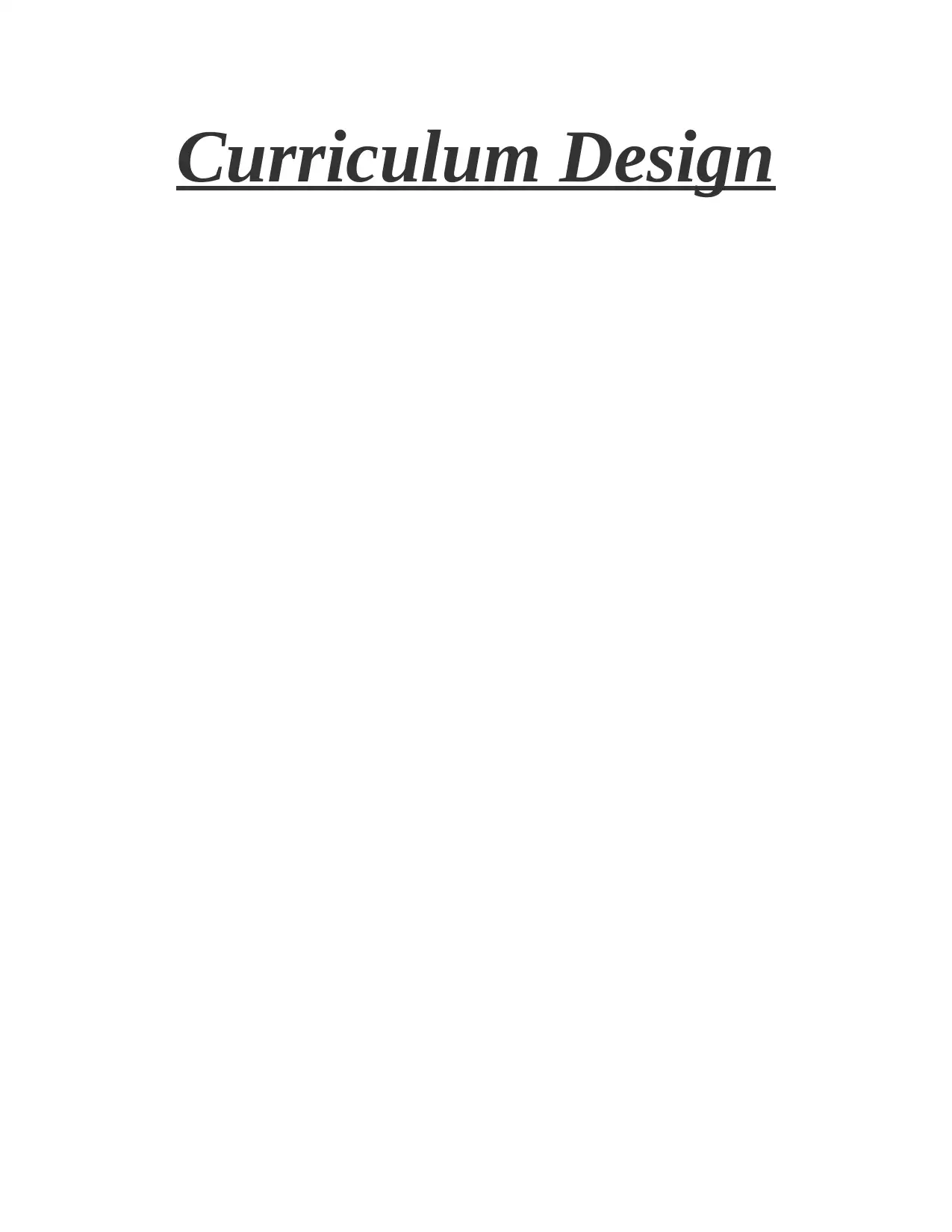
Curriculum Design
Paraphrase This Document
Need a fresh take? Get an instant paraphrase of this document with our AI Paraphraser
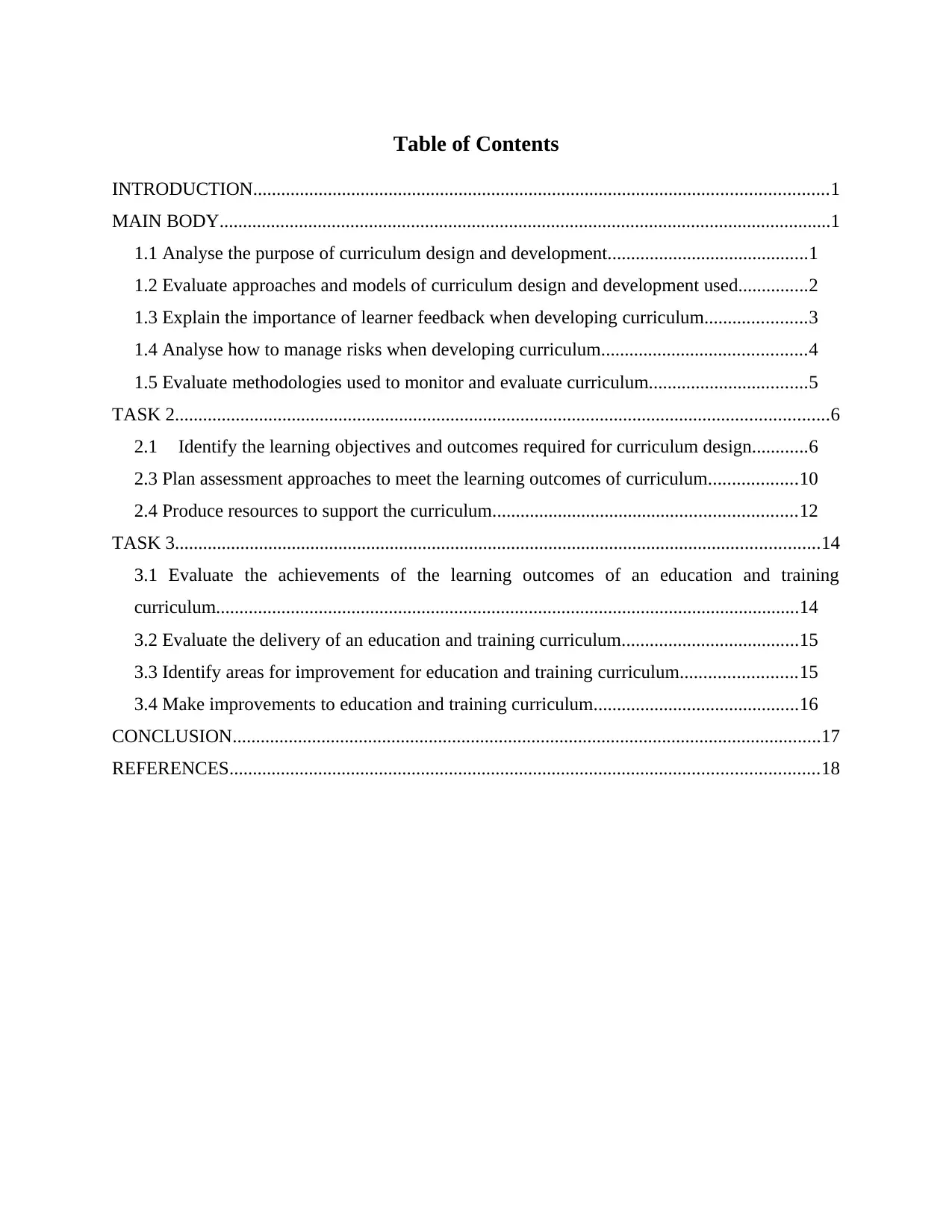
Table of Contents
INTRODUCTION...........................................................................................................................1
MAIN BODY...................................................................................................................................1
1.1 Analyse the purpose of curriculum design and development...........................................1
1.2 Evaluate approaches and models of curriculum design and development used...............2
1.3 Explain the importance of learner feedback when developing curriculum......................3
1.4 Analyse how to manage risks when developing curriculum............................................4
1.5 Evaluate methodologies used to monitor and evaluate curriculum..................................5
TASK 2............................................................................................................................................6
2.1 Identify the learning objectives and outcomes required for curriculum design............6
2.3 Plan assessment approaches to meet the learning outcomes of curriculum...................10
2.4 Produce resources to support the curriculum.................................................................12
TASK 3..........................................................................................................................................14
3.1 Evaluate the achievements of the learning outcomes of an education and training
curriculum.............................................................................................................................14
3.2 Evaluate the delivery of an education and training curriculum......................................15
3.3 Identify areas for improvement for education and training curriculum.........................15
3.4 Make improvements to education and training curriculum............................................16
CONCLUSION..............................................................................................................................17
REFERENCES..............................................................................................................................18
INTRODUCTION...........................................................................................................................1
MAIN BODY...................................................................................................................................1
1.1 Analyse the purpose of curriculum design and development...........................................1
1.2 Evaluate approaches and models of curriculum design and development used...............2
1.3 Explain the importance of learner feedback when developing curriculum......................3
1.4 Analyse how to manage risks when developing curriculum............................................4
1.5 Evaluate methodologies used to monitor and evaluate curriculum..................................5
TASK 2............................................................................................................................................6
2.1 Identify the learning objectives and outcomes required for curriculum design............6
2.3 Plan assessment approaches to meet the learning outcomes of curriculum...................10
2.4 Produce resources to support the curriculum.................................................................12
TASK 3..........................................................................................................................................14
3.1 Evaluate the achievements of the learning outcomes of an education and training
curriculum.............................................................................................................................14
3.2 Evaluate the delivery of an education and training curriculum......................................15
3.3 Identify areas for improvement for education and training curriculum.........................15
3.4 Make improvements to education and training curriculum............................................16
CONCLUSION..............................................................................................................................17
REFERENCES..............................................................................................................................18
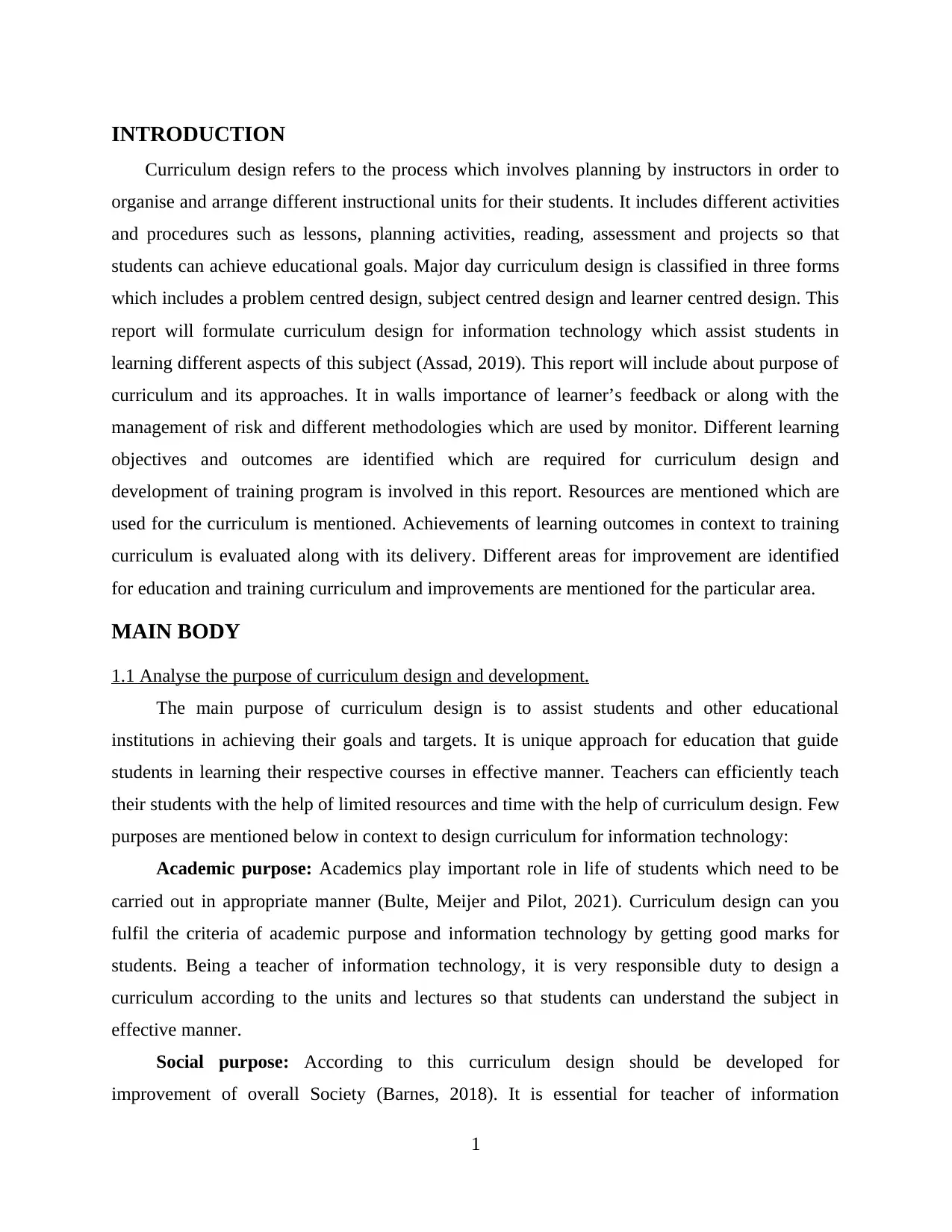
INTRODUCTION
Curriculum design refers to the process which involves planning by instructors in order to
organise and arrange different instructional units for their students. It includes different activities
and procedures such as lessons, planning activities, reading, assessment and projects so that
students can achieve educational goals. Major day curriculum design is classified in three forms
which includes a problem centred design, subject centred design and learner centred design. This
report will formulate curriculum design for information technology which assist students in
learning different aspects of this subject (Assad, 2019). This report will include about purpose of
curriculum and its approaches. It in walls importance of learner’s feedback or along with the
management of risk and different methodologies which are used by monitor. Different learning
objectives and outcomes are identified which are required for curriculum design and
development of training program is involved in this report. Resources are mentioned which are
used for the curriculum is mentioned. Achievements of learning outcomes in context to training
curriculum is evaluated along with its delivery. Different areas for improvement are identified
for education and training curriculum and improvements are mentioned for the particular area.
MAIN BODY
1.1 Analyse the purpose of curriculum design and development.
The main purpose of curriculum design is to assist students and other educational
institutions in achieving their goals and targets. It is unique approach for education that guide
students in learning their respective courses in effective manner. Teachers can efficiently teach
their students with the help of limited resources and time with the help of curriculum design. Few
purposes are mentioned below in context to design curriculum for information technology:
Academic purpose: Academics play important role in life of students which need to be
carried out in appropriate manner (Bulte, Meijer and Pilot, 2021). Curriculum design can you
fulfil the criteria of academic purpose and information technology by getting good marks for
students. Being a teacher of information technology, it is very responsible duty to design a
curriculum according to the units and lectures so that students can understand the subject in
effective manner.
Social purpose: According to this curriculum design should be developed for
improvement of overall Society (Barnes, 2018). It is essential for teacher of information
1
Curriculum design refers to the process which involves planning by instructors in order to
organise and arrange different instructional units for their students. It includes different activities
and procedures such as lessons, planning activities, reading, assessment and projects so that
students can achieve educational goals. Major day curriculum design is classified in three forms
which includes a problem centred design, subject centred design and learner centred design. This
report will formulate curriculum design for information technology which assist students in
learning different aspects of this subject (Assad, 2019). This report will include about purpose of
curriculum and its approaches. It in walls importance of learner’s feedback or along with the
management of risk and different methodologies which are used by monitor. Different learning
objectives and outcomes are identified which are required for curriculum design and
development of training program is involved in this report. Resources are mentioned which are
used for the curriculum is mentioned. Achievements of learning outcomes in context to training
curriculum is evaluated along with its delivery. Different areas for improvement are identified
for education and training curriculum and improvements are mentioned for the particular area.
MAIN BODY
1.1 Analyse the purpose of curriculum design and development.
The main purpose of curriculum design is to assist students and other educational
institutions in achieving their goals and targets. It is unique approach for education that guide
students in learning their respective courses in effective manner. Teachers can efficiently teach
their students with the help of limited resources and time with the help of curriculum design. Few
purposes are mentioned below in context to design curriculum for information technology:
Academic purpose: Academics play important role in life of students which need to be
carried out in appropriate manner (Bulte, Meijer and Pilot, 2021). Curriculum design can you
fulfil the criteria of academic purpose and information technology by getting good marks for
students. Being a teacher of information technology, it is very responsible duty to design a
curriculum according to the units and lectures so that students can understand the subject in
effective manner.
Social purpose: According to this curriculum design should be developed for
improvement of overall Society (Barnes, 2018). It is essential for teacher of information
1
⊘ This is a preview!⊘
Do you want full access?
Subscribe today to unlock all pages.

Trusted by 1+ million students worldwide
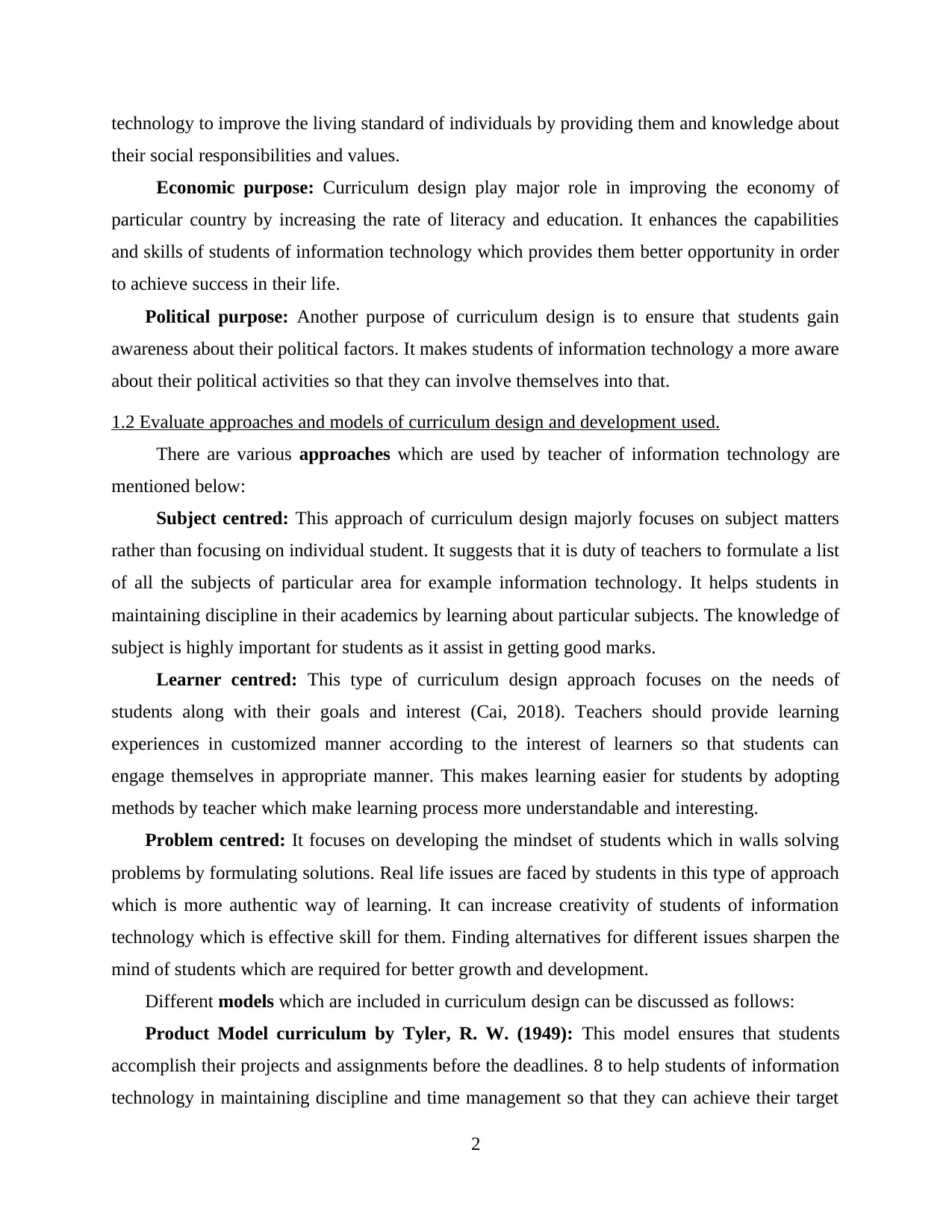
technology to improve the living standard of individuals by providing them and knowledge about
their social responsibilities and values.
Economic purpose: Curriculum design play major role in improving the economy of
particular country by increasing the rate of literacy and education. It enhances the capabilities
and skills of students of information technology which provides them better opportunity in order
to achieve success in their life.
Political purpose: Another purpose of curriculum design is to ensure that students gain
awareness about their political factors. It makes students of information technology a more aware
about their political activities so that they can involve themselves into that.
1.2 Evaluate approaches and models of curriculum design and development used.
There are various approaches which are used by teacher of information technology are
mentioned below:
Subject centred: This approach of curriculum design majorly focuses on subject matters
rather than focusing on individual student. It suggests that it is duty of teachers to formulate a list
of all the subjects of particular area for example information technology. It helps students in
maintaining discipline in their academics by learning about particular subjects. The knowledge of
subject is highly important for students as it assist in getting good marks.
Learner centred: This type of curriculum design approach focuses on the needs of
students along with their goals and interest (Cai, 2018). Teachers should provide learning
experiences in customized manner according to the interest of learners so that students can
engage themselves in appropriate manner. This makes learning easier for students by adopting
methods by teacher which make learning process more understandable and interesting.
Problem centred: It focuses on developing the mindset of students which in walls solving
problems by formulating solutions. Real life issues are faced by students in this type of approach
which is more authentic way of learning. It can increase creativity of students of information
technology which is effective skill for them. Finding alternatives for different issues sharpen the
mind of students which are required for better growth and development.
Different models which are included in curriculum design can be discussed as follows:
Product Model curriculum by Tyler, R. W. (1949): This model ensures that students
accomplish their projects and assignments before the deadlines. 8 to help students of information
technology in maintaining discipline and time management so that they can achieve their target
2
their social responsibilities and values.
Economic purpose: Curriculum design play major role in improving the economy of
particular country by increasing the rate of literacy and education. It enhances the capabilities
and skills of students of information technology which provides them better opportunity in order
to achieve success in their life.
Political purpose: Another purpose of curriculum design is to ensure that students gain
awareness about their political factors. It makes students of information technology a more aware
about their political activities so that they can involve themselves into that.
1.2 Evaluate approaches and models of curriculum design and development used.
There are various approaches which are used by teacher of information technology are
mentioned below:
Subject centred: This approach of curriculum design majorly focuses on subject matters
rather than focusing on individual student. It suggests that it is duty of teachers to formulate a list
of all the subjects of particular area for example information technology. It helps students in
maintaining discipline in their academics by learning about particular subjects. The knowledge of
subject is highly important for students as it assist in getting good marks.
Learner centred: This type of curriculum design approach focuses on the needs of
students along with their goals and interest (Cai, 2018). Teachers should provide learning
experiences in customized manner according to the interest of learners so that students can
engage themselves in appropriate manner. This makes learning easier for students by adopting
methods by teacher which make learning process more understandable and interesting.
Problem centred: It focuses on developing the mindset of students which in walls solving
problems by formulating solutions. Real life issues are faced by students in this type of approach
which is more authentic way of learning. It can increase creativity of students of information
technology which is effective skill for them. Finding alternatives for different issues sharpen the
mind of students which are required for better growth and development.
Different models which are included in curriculum design can be discussed as follows:
Product Model curriculum by Tyler, R. W. (1949): This model ensures that students
accomplish their projects and assignments before the deadlines. 8 to help students of information
technology in maintaining discipline and time management so that they can achieve their target
2
Paraphrase This Document
Need a fresh take? Get an instant paraphrase of this document with our AI Paraphraser
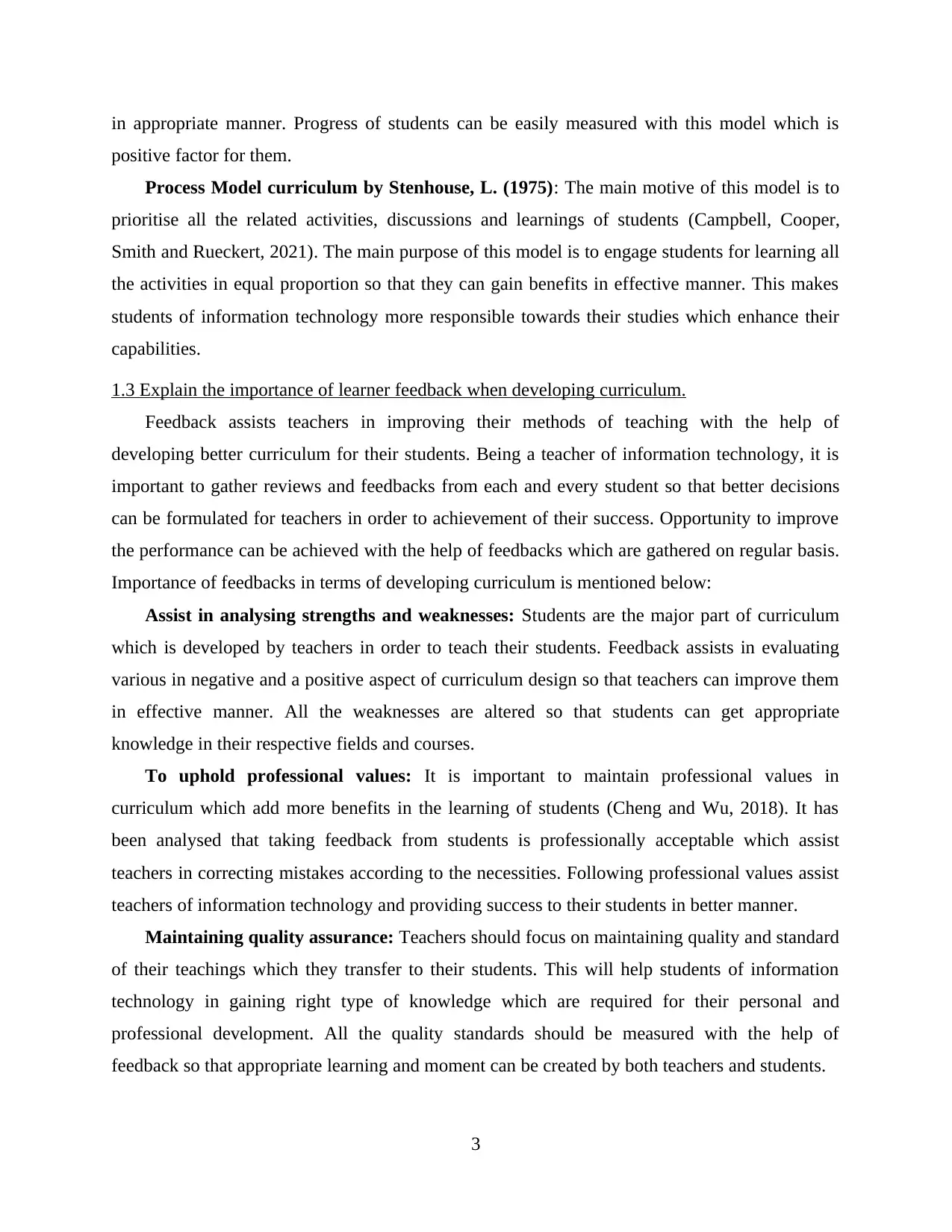
in appropriate manner. Progress of students can be easily measured with this model which is
positive factor for them.
Process Model curriculum by Stenhouse, L. (1975): The main motive of this model is to
prioritise all the related activities, discussions and learnings of students (Campbell, Cooper,
Smith and Rueckert, 2021). The main purpose of this model is to engage students for learning all
the activities in equal proportion so that they can gain benefits in effective manner. This makes
students of information technology more responsible towards their studies which enhance their
capabilities.
1.3 Explain the importance of learner feedback when developing curriculum.
Feedback assists teachers in improving their methods of teaching with the help of
developing better curriculum for their students. Being a teacher of information technology, it is
important to gather reviews and feedbacks from each and every student so that better decisions
can be formulated for teachers in order to achievement of their success. Opportunity to improve
the performance can be achieved with the help of feedbacks which are gathered on regular basis.
Importance of feedbacks in terms of developing curriculum is mentioned below:
Assist in analysing strengths and weaknesses: Students are the major part of curriculum
which is developed by teachers in order to teach their students. Feedback assists in evaluating
various in negative and a positive aspect of curriculum design so that teachers can improve them
in effective manner. All the weaknesses are altered so that students can get appropriate
knowledge in their respective fields and courses.
To uphold professional values: It is important to maintain professional values in
curriculum which add more benefits in the learning of students (Cheng and Wu, 2018). It has
been analysed that taking feedback from students is professionally acceptable which assist
teachers in correcting mistakes according to the necessities. Following professional values assist
teachers of information technology and providing success to their students in better manner.
Maintaining quality assurance: Teachers should focus on maintaining quality and standard
of their teachings which they transfer to their students. This will help students of information
technology in gaining right type of knowledge which are required for their personal and
professional development. All the quality standards should be measured with the help of
feedback so that appropriate learning and moment can be created by both teachers and students.
3
positive factor for them.
Process Model curriculum by Stenhouse, L. (1975): The main motive of this model is to
prioritise all the related activities, discussions and learnings of students (Campbell, Cooper,
Smith and Rueckert, 2021). The main purpose of this model is to engage students for learning all
the activities in equal proportion so that they can gain benefits in effective manner. This makes
students of information technology more responsible towards their studies which enhance their
capabilities.
1.3 Explain the importance of learner feedback when developing curriculum.
Feedback assists teachers in improving their methods of teaching with the help of
developing better curriculum for their students. Being a teacher of information technology, it is
important to gather reviews and feedbacks from each and every student so that better decisions
can be formulated for teachers in order to achievement of their success. Opportunity to improve
the performance can be achieved with the help of feedbacks which are gathered on regular basis.
Importance of feedbacks in terms of developing curriculum is mentioned below:
Assist in analysing strengths and weaknesses: Students are the major part of curriculum
which is developed by teachers in order to teach their students. Feedback assists in evaluating
various in negative and a positive aspect of curriculum design so that teachers can improve them
in effective manner. All the weaknesses are altered so that students can get appropriate
knowledge in their respective fields and courses.
To uphold professional values: It is important to maintain professional values in
curriculum which add more benefits in the learning of students (Cheng and Wu, 2018). It has
been analysed that taking feedback from students is professionally acceptable which assist
teachers in correcting mistakes according to the necessities. Following professional values assist
teachers of information technology and providing success to their students in better manner.
Maintaining quality assurance: Teachers should focus on maintaining quality and standard
of their teachings which they transfer to their students. This will help students of information
technology in gaining right type of knowledge which are required for their personal and
professional development. All the quality standards should be measured with the help of
feedback so that appropriate learning and moment can be created by both teachers and students.
3
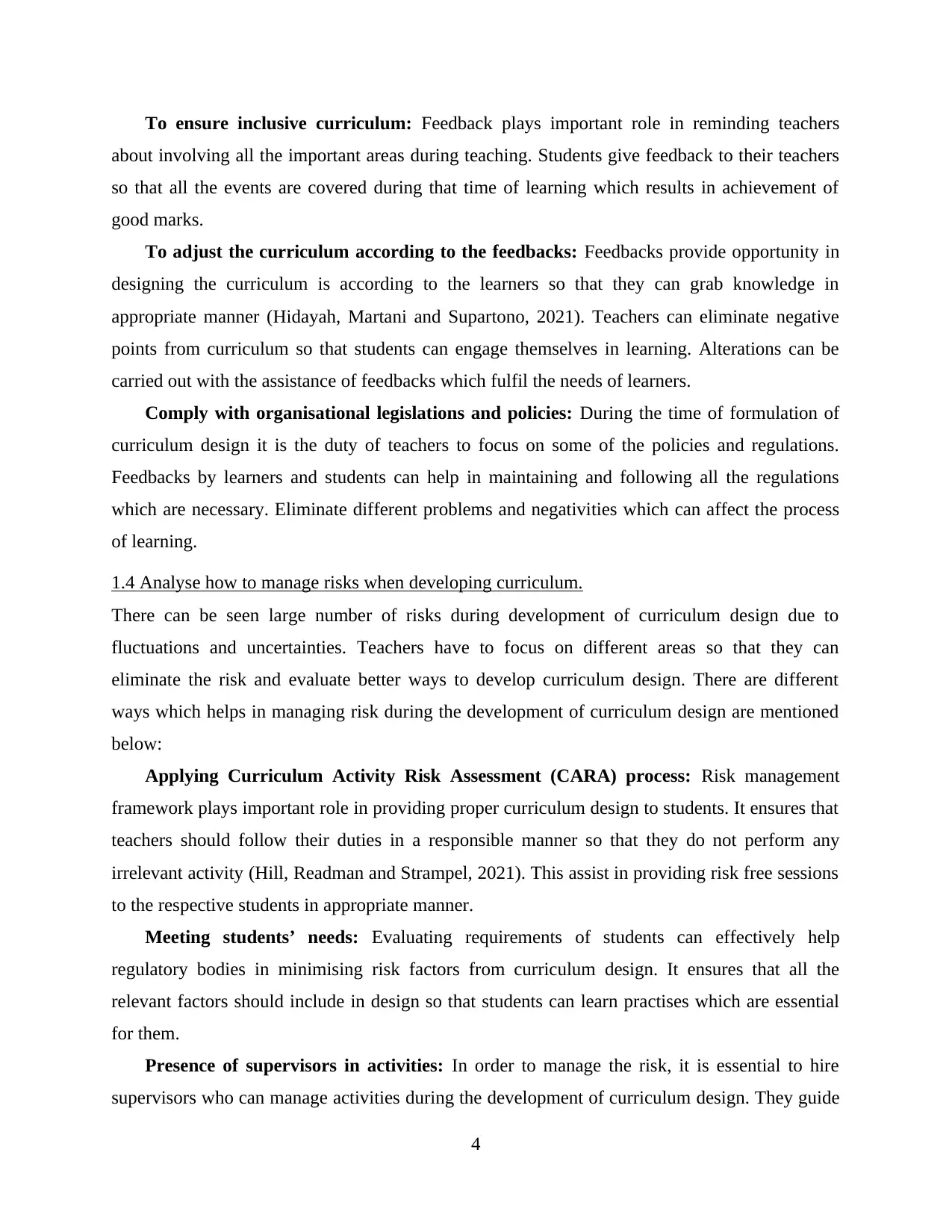
To ensure inclusive curriculum: Feedback plays important role in reminding teachers
about involving all the important areas during teaching. Students give feedback to their teachers
so that all the events are covered during that time of learning which results in achievement of
good marks.
To adjust the curriculum according to the feedbacks: Feedbacks provide opportunity in
designing the curriculum is according to the learners so that they can grab knowledge in
appropriate manner (Hidayah, Martani and Supartono, 2021). Teachers can eliminate negative
points from curriculum so that students can engage themselves in learning. Alterations can be
carried out with the assistance of feedbacks which fulfil the needs of learners.
Comply with organisational legislations and policies: During the time of formulation of
curriculum design it is the duty of teachers to focus on some of the policies and regulations.
Feedbacks by learners and students can help in maintaining and following all the regulations
which are necessary. Eliminate different problems and negativities which can affect the process
of learning.
1.4 Analyse how to manage risks when developing curriculum.
There can be seen large number of risks during development of curriculum design due to
fluctuations and uncertainties. Teachers have to focus on different areas so that they can
eliminate the risk and evaluate better ways to develop curriculum design. There are different
ways which helps in managing risk during the development of curriculum design are mentioned
below:
Applying Curriculum Activity Risk Assessment (CARA) process: Risk management
framework plays important role in providing proper curriculum design to students. It ensures that
teachers should follow their duties in a responsible manner so that they do not perform any
irrelevant activity (Hill, Readman and Strampel, 2021). This assist in providing risk free sessions
to the respective students in appropriate manner.
Meeting students’ needs: Evaluating requirements of students can effectively help
regulatory bodies in minimising risk factors from curriculum design. It ensures that all the
relevant factors should include in design so that students can learn practises which are essential
for them.
Presence of supervisors in activities: In order to manage the risk, it is essential to hire
supervisors who can manage activities during the development of curriculum design. They guide
4
about involving all the important areas during teaching. Students give feedback to their teachers
so that all the events are covered during that time of learning which results in achievement of
good marks.
To adjust the curriculum according to the feedbacks: Feedbacks provide opportunity in
designing the curriculum is according to the learners so that they can grab knowledge in
appropriate manner (Hidayah, Martani and Supartono, 2021). Teachers can eliminate negative
points from curriculum so that students can engage themselves in learning. Alterations can be
carried out with the assistance of feedbacks which fulfil the needs of learners.
Comply with organisational legislations and policies: During the time of formulation of
curriculum design it is the duty of teachers to focus on some of the policies and regulations.
Feedbacks by learners and students can help in maintaining and following all the regulations
which are necessary. Eliminate different problems and negativities which can affect the process
of learning.
1.4 Analyse how to manage risks when developing curriculum.
There can be seen large number of risks during development of curriculum design due to
fluctuations and uncertainties. Teachers have to focus on different areas so that they can
eliminate the risk and evaluate better ways to develop curriculum design. There are different
ways which helps in managing risk during the development of curriculum design are mentioned
below:
Applying Curriculum Activity Risk Assessment (CARA) process: Risk management
framework plays important role in providing proper curriculum design to students. It ensures that
teachers should follow their duties in a responsible manner so that they do not perform any
irrelevant activity (Hill, Readman and Strampel, 2021). This assist in providing risk free sessions
to the respective students in appropriate manner.
Meeting students’ needs: Evaluating requirements of students can effectively help
regulatory bodies in minimising risk factors from curriculum design. It ensures that all the
relevant factors should include in design so that students can learn practises which are essential
for them.
Presence of supervisors in activities: In order to manage the risk, it is essential to hire
supervisors who can manage activities during the development of curriculum design. They guide
4
⊘ This is a preview!⊘
Do you want full access?
Subscribe today to unlock all pages.

Trusted by 1+ million students worldwide
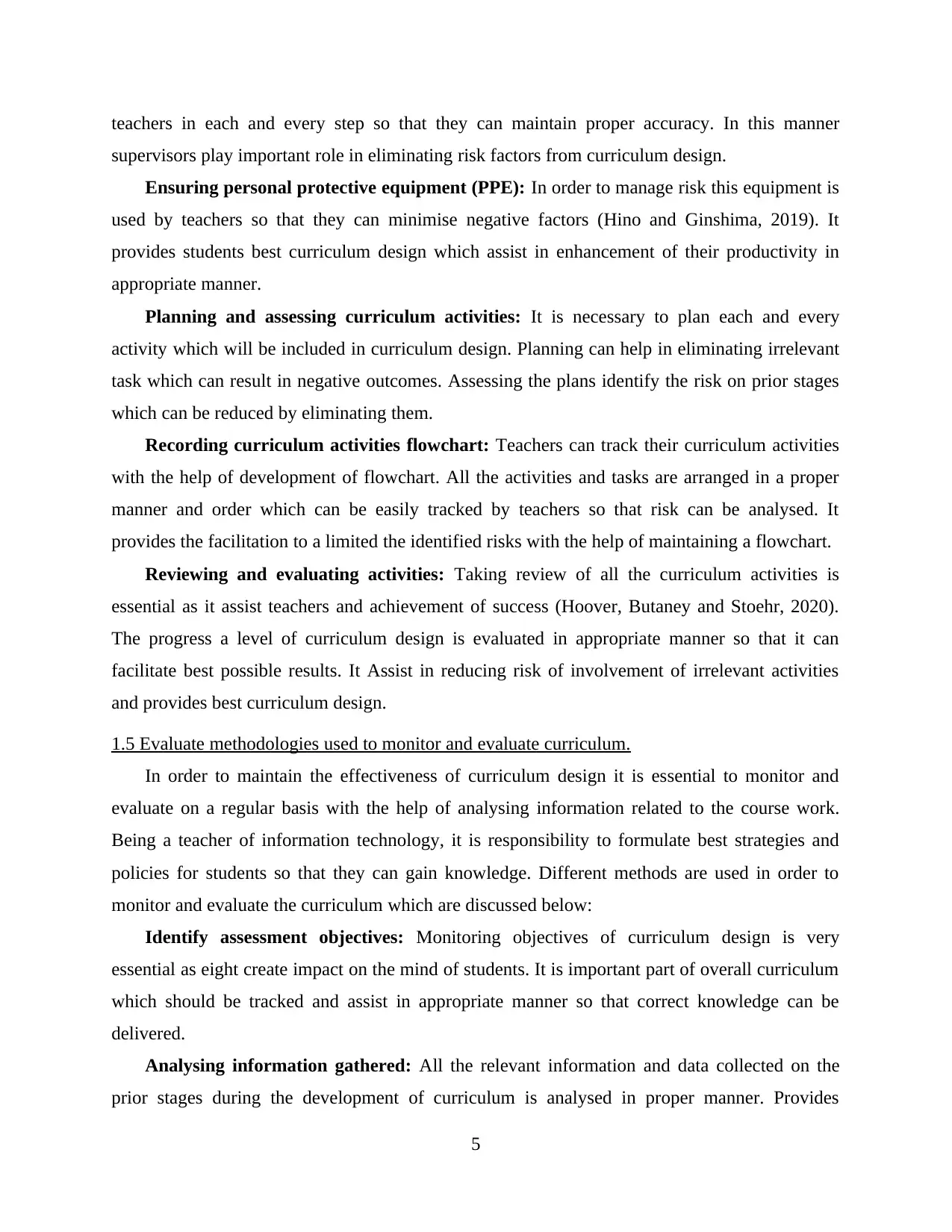
teachers in each and every step so that they can maintain proper accuracy. In this manner
supervisors play important role in eliminating risk factors from curriculum design.
Ensuring personal protective equipment (PPE): In order to manage risk this equipment is
used by teachers so that they can minimise negative factors (Hino and Ginshima, 2019). It
provides students best curriculum design which assist in enhancement of their productivity in
appropriate manner.
Planning and assessing curriculum activities: It is necessary to plan each and every
activity which will be included in curriculum design. Planning can help in eliminating irrelevant
task which can result in negative outcomes. Assessing the plans identify the risk on prior stages
which can be reduced by eliminating them.
Recording curriculum activities flowchart: Teachers can track their curriculum activities
with the help of development of flowchart. All the activities and tasks are arranged in a proper
manner and order which can be easily tracked by teachers so that risk can be analysed. It
provides the facilitation to a limited the identified risks with the help of maintaining a flowchart.
Reviewing and evaluating activities: Taking review of all the curriculum activities is
essential as it assist teachers and achievement of success (Hoover, Butaney and Stoehr, 2020).
The progress a level of curriculum design is evaluated in appropriate manner so that it can
facilitate best possible results. It Assist in reducing risk of involvement of irrelevant activities
and provides best curriculum design.
1.5 Evaluate methodologies used to monitor and evaluate curriculum.
In order to maintain the effectiveness of curriculum design it is essential to monitor and
evaluate on a regular basis with the help of analysing information related to the course work.
Being a teacher of information technology, it is responsibility to formulate best strategies and
policies for students so that they can gain knowledge. Different methods are used in order to
monitor and evaluate the curriculum which are discussed below:
Identify assessment objectives: Monitoring objectives of curriculum design is very
essential as eight create impact on the mind of students. It is important part of overall curriculum
which should be tracked and assist in appropriate manner so that correct knowledge can be
delivered.
Analysing information gathered: All the relevant information and data collected on the
prior stages during the development of curriculum is analysed in proper manner. Provides
5
supervisors play important role in eliminating risk factors from curriculum design.
Ensuring personal protective equipment (PPE): In order to manage risk this equipment is
used by teachers so that they can minimise negative factors (Hino and Ginshima, 2019). It
provides students best curriculum design which assist in enhancement of their productivity in
appropriate manner.
Planning and assessing curriculum activities: It is necessary to plan each and every
activity which will be included in curriculum design. Planning can help in eliminating irrelevant
task which can result in negative outcomes. Assessing the plans identify the risk on prior stages
which can be reduced by eliminating them.
Recording curriculum activities flowchart: Teachers can track their curriculum activities
with the help of development of flowchart. All the activities and tasks are arranged in a proper
manner and order which can be easily tracked by teachers so that risk can be analysed. It
provides the facilitation to a limited the identified risks with the help of maintaining a flowchart.
Reviewing and evaluating activities: Taking review of all the curriculum activities is
essential as it assist teachers and achievement of success (Hoover, Butaney and Stoehr, 2020).
The progress a level of curriculum design is evaluated in appropriate manner so that it can
facilitate best possible results. It Assist in reducing risk of involvement of irrelevant activities
and provides best curriculum design.
1.5 Evaluate methodologies used to monitor and evaluate curriculum.
In order to maintain the effectiveness of curriculum design it is essential to monitor and
evaluate on a regular basis with the help of analysing information related to the course work.
Being a teacher of information technology, it is responsibility to formulate best strategies and
policies for students so that they can gain knowledge. Different methods are used in order to
monitor and evaluate the curriculum which are discussed below:
Identify assessment objectives: Monitoring objectives of curriculum design is very
essential as eight create impact on the mind of students. It is important part of overall curriculum
which should be tracked and assist in appropriate manner so that correct knowledge can be
delivered.
Analysing information gathered: All the relevant information and data collected on the
prior stages during the development of curriculum is analysed in proper manner. Provides
5
Paraphrase This Document
Need a fresh take? Get an instant paraphrase of this document with our AI Paraphraser
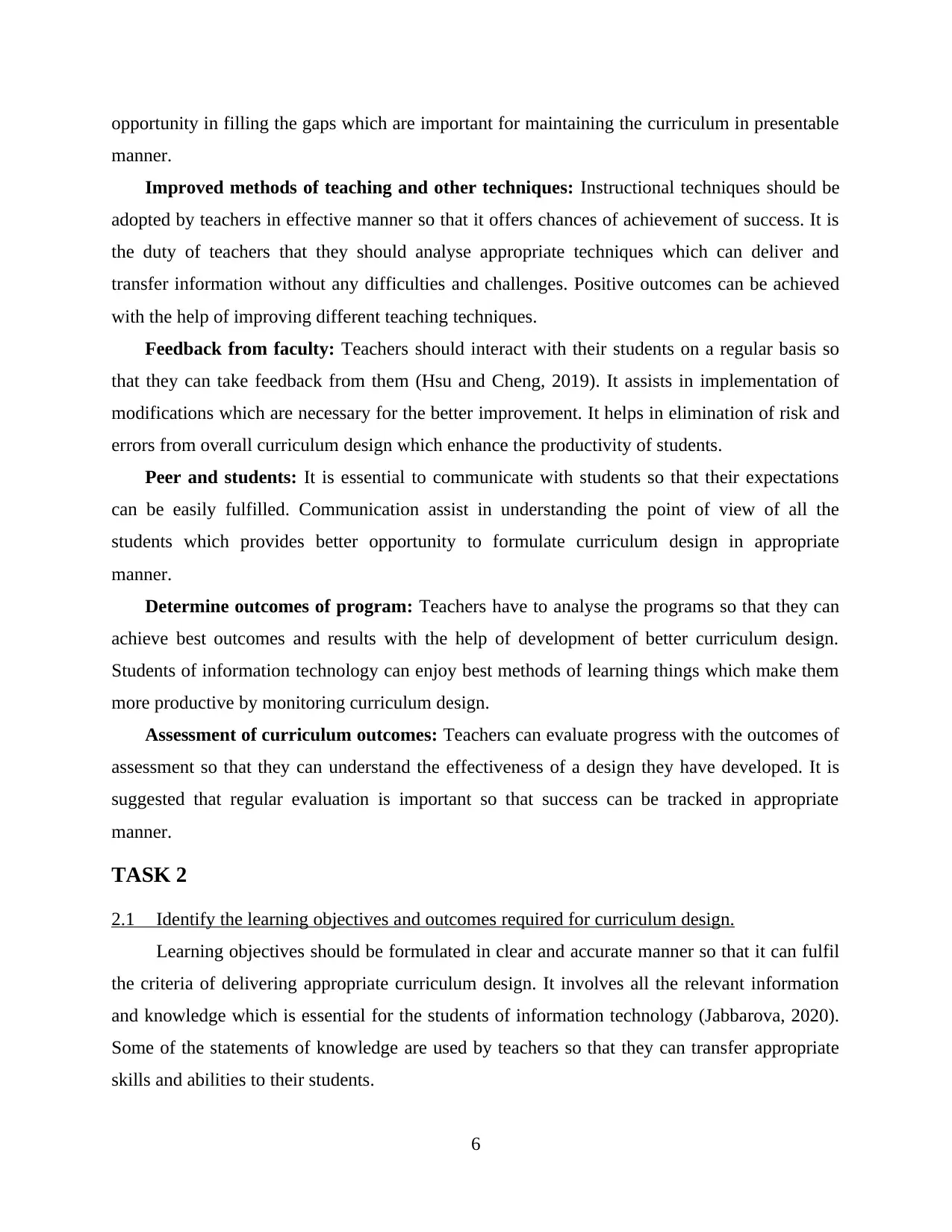
opportunity in filling the gaps which are important for maintaining the curriculum in presentable
manner.
Improved methods of teaching and other techniques: Instructional techniques should be
adopted by teachers in effective manner so that it offers chances of achievement of success. It is
the duty of teachers that they should analyse appropriate techniques which can deliver and
transfer information without any difficulties and challenges. Positive outcomes can be achieved
with the help of improving different teaching techniques.
Feedback from faculty: Teachers should interact with their students on a regular basis so
that they can take feedback from them (Hsu and Cheng, 2019). It assists in implementation of
modifications which are necessary for the better improvement. It helps in elimination of risk and
errors from overall curriculum design which enhance the productivity of students.
Peer and students: It is essential to communicate with students so that their expectations
can be easily fulfilled. Communication assist in understanding the point of view of all the
students which provides better opportunity to formulate curriculum design in appropriate
manner.
Determine outcomes of program: Teachers have to analyse the programs so that they can
achieve best outcomes and results with the help of development of better curriculum design.
Students of information technology can enjoy best methods of learning things which make them
more productive by monitoring curriculum design.
Assessment of curriculum outcomes: Teachers can evaluate progress with the outcomes of
assessment so that they can understand the effectiveness of a design they have developed. It is
suggested that regular evaluation is important so that success can be tracked in appropriate
manner.
TASK 2
2.1 Identify the learning objectives and outcomes required for curriculum design.
Learning objectives should be formulated in clear and accurate manner so that it can fulfil
the criteria of delivering appropriate curriculum design. It involves all the relevant information
and knowledge which is essential for the students of information technology (Jabbarova, 2020).
Some of the statements of knowledge are used by teachers so that they can transfer appropriate
skills and abilities to their students.
6
manner.
Improved methods of teaching and other techniques: Instructional techniques should be
adopted by teachers in effective manner so that it offers chances of achievement of success. It is
the duty of teachers that they should analyse appropriate techniques which can deliver and
transfer information without any difficulties and challenges. Positive outcomes can be achieved
with the help of improving different teaching techniques.
Feedback from faculty: Teachers should interact with their students on a regular basis so
that they can take feedback from them (Hsu and Cheng, 2019). It assists in implementation of
modifications which are necessary for the better improvement. It helps in elimination of risk and
errors from overall curriculum design which enhance the productivity of students.
Peer and students: It is essential to communicate with students so that their expectations
can be easily fulfilled. Communication assist in understanding the point of view of all the
students which provides better opportunity to formulate curriculum design in appropriate
manner.
Determine outcomes of program: Teachers have to analyse the programs so that they can
achieve best outcomes and results with the help of development of better curriculum design.
Students of information technology can enjoy best methods of learning things which make them
more productive by monitoring curriculum design.
Assessment of curriculum outcomes: Teachers can evaluate progress with the outcomes of
assessment so that they can understand the effectiveness of a design they have developed. It is
suggested that regular evaluation is important so that success can be tracked in appropriate
manner.
TASK 2
2.1 Identify the learning objectives and outcomes required for curriculum design.
Learning objectives should be formulated in clear and accurate manner so that it can fulfil
the criteria of delivering appropriate curriculum design. It involves all the relevant information
and knowledge which is essential for the students of information technology (Jabbarova, 2020).
Some of the statements of knowledge are used by teachers so that they can transfer appropriate
skills and abilities to their students.
6
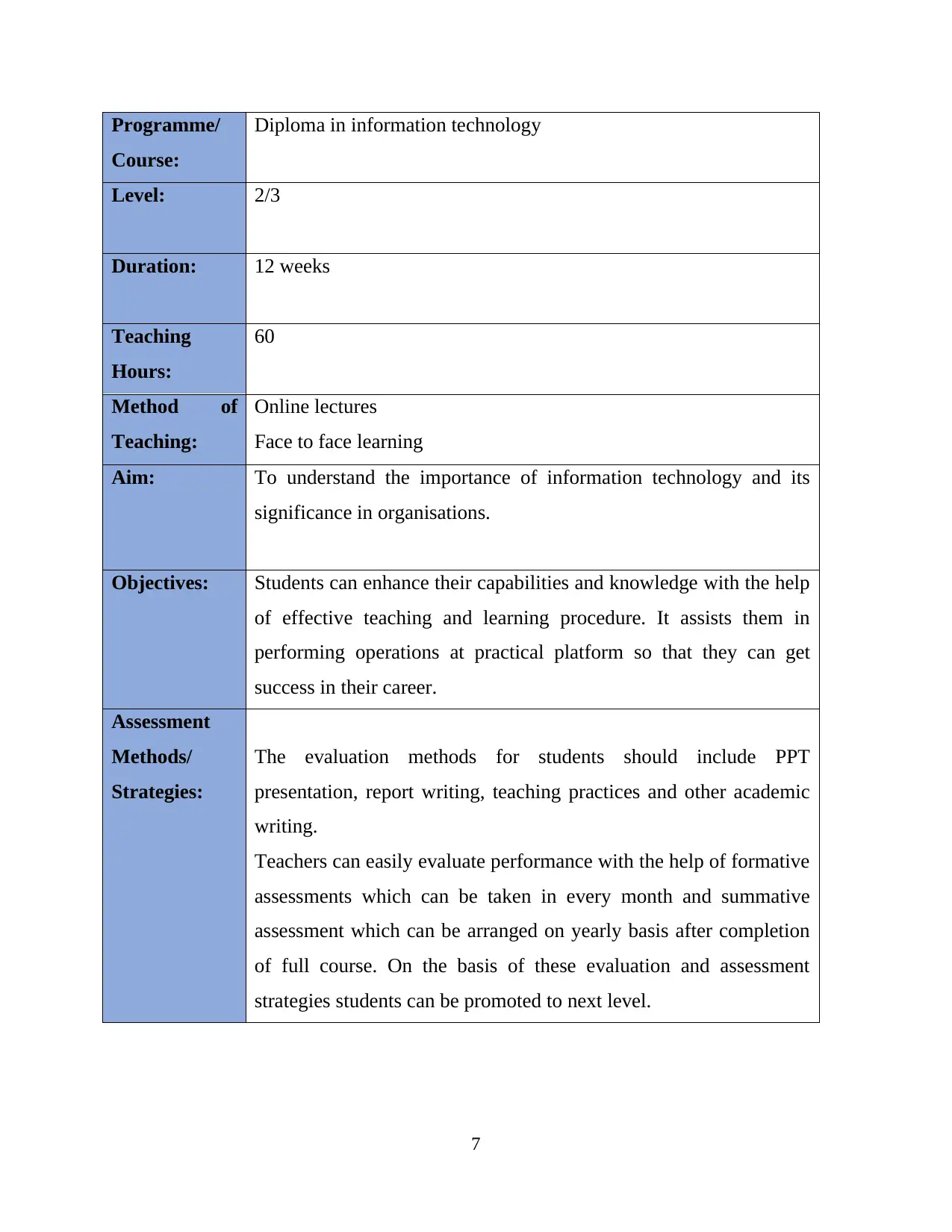
Programme/
Course:
Diploma in information technology
Level: 2/3
Duration: 12 weeks
Teaching
Hours:
60
Method of
Teaching:
Online lectures
Face to face learning
Aim: To understand the importance of information technology and its
significance in organisations.
Objectives: Students can enhance their capabilities and knowledge with the help
of effective teaching and learning procedure. It assists them in
performing operations at practical platform so that they can get
success in their career.
Assessment
Methods/
Strategies:
The evaluation methods for students should include PPT
presentation, report writing, teaching practices and other academic
writing.
Teachers can easily evaluate performance with the help of formative
assessments which can be taken in every month and summative
assessment which can be arranged on yearly basis after completion
of full course. On the basis of these evaluation and assessment
strategies students can be promoted to next level.
7
Course:
Diploma in information technology
Level: 2/3
Duration: 12 weeks
Teaching
Hours:
60
Method of
Teaching:
Online lectures
Face to face learning
Aim: To understand the importance of information technology and its
significance in organisations.
Objectives: Students can enhance their capabilities and knowledge with the help
of effective teaching and learning procedure. It assists them in
performing operations at practical platform so that they can get
success in their career.
Assessment
Methods/
Strategies:
The evaluation methods for students should include PPT
presentation, report writing, teaching practices and other academic
writing.
Teachers can easily evaluate performance with the help of formative
assessments which can be taken in every month and summative
assessment which can be arranged on yearly basis after completion
of full course. On the basis of these evaluation and assessment
strategies students can be promoted to next level.
7
⊘ This is a preview!⊘
Do you want full access?
Subscribe today to unlock all pages.

Trusted by 1+ million students worldwide
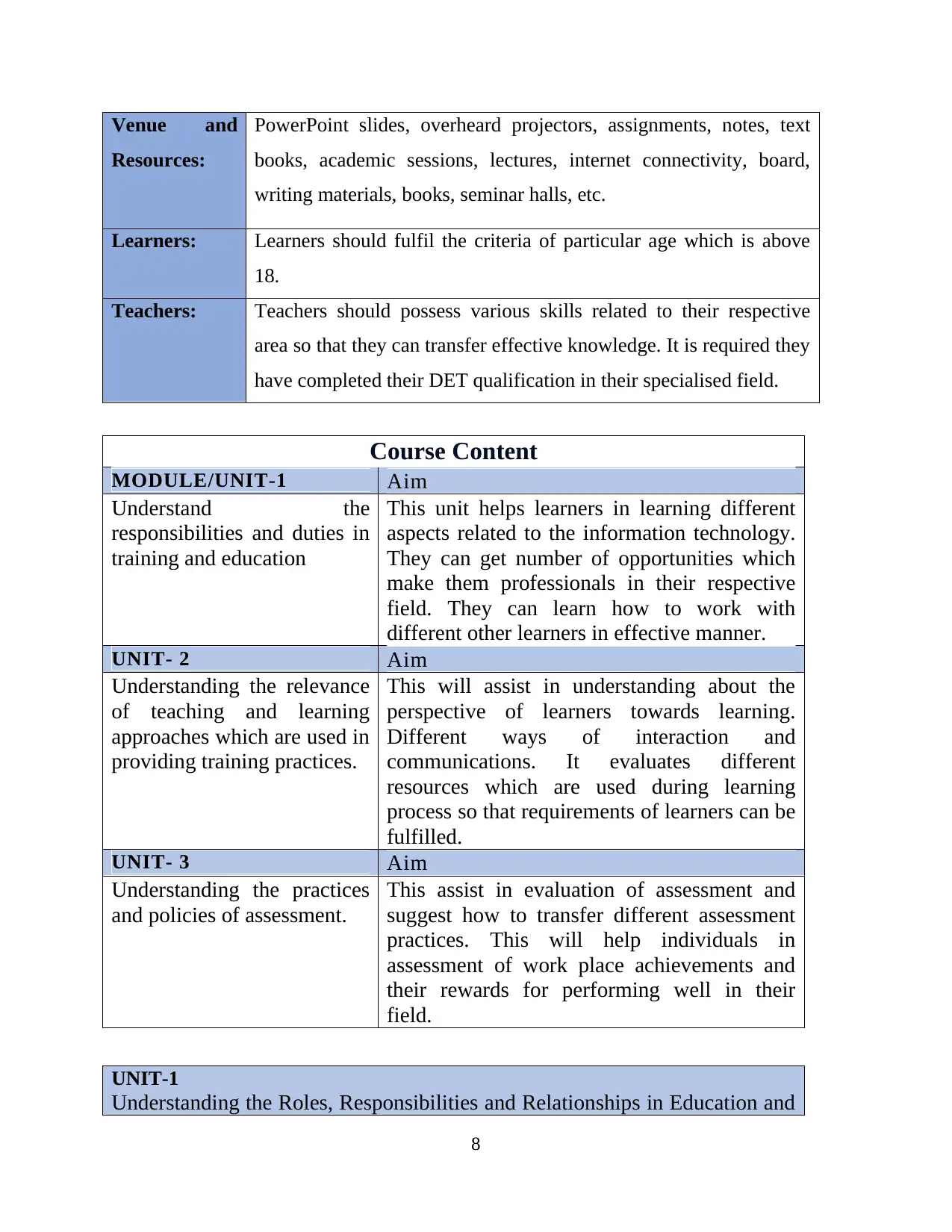
Venue and
Resources:
PowerPoint slides, overheard projectors, assignments, notes, text
books, academic sessions, lectures, internet connectivity, board,
writing materials, books, seminar halls, etc.
Learners: Learners should fulfil the criteria of particular age which is above
18.
Teachers: Teachers should possess various skills related to their respective
area so that they can transfer effective knowledge. It is required they
have completed their DET qualification in their specialised field.
Course Content
MODULE/UNIT-1 Aim
Understand the
responsibilities and duties in
training and education
This unit helps learners in learning different
aspects related to the information technology.
They can get number of opportunities which
make them professionals in their respective
field. They can learn how to work with
different other learners in effective manner.
UNIT- 2 Aim
Understanding the relevance
of teaching and learning
approaches which are used in
providing training practices.
This will assist in understanding about the
perspective of learners towards learning.
Different ways of interaction and
communications. It evaluates different
resources which are used during learning
process so that requirements of learners can be
fulfilled.
UNIT- 3 Aim
Understanding the practices
and policies of assessment.
This assist in evaluation of assessment and
suggest how to transfer different assessment
practices. This will help individuals in
assessment of work place achievements and
their rewards for performing well in their
field.
UNIT-1
Understanding the Roles, Responsibilities and Relationships in Education and
8
Resources:
PowerPoint slides, overheard projectors, assignments, notes, text
books, academic sessions, lectures, internet connectivity, board,
writing materials, books, seminar halls, etc.
Learners: Learners should fulfil the criteria of particular age which is above
18.
Teachers: Teachers should possess various skills related to their respective
area so that they can transfer effective knowledge. It is required they
have completed their DET qualification in their specialised field.
Course Content
MODULE/UNIT-1 Aim
Understand the
responsibilities and duties in
training and education
This unit helps learners in learning different
aspects related to the information technology.
They can get number of opportunities which
make them professionals in their respective
field. They can learn how to work with
different other learners in effective manner.
UNIT- 2 Aim
Understanding the relevance
of teaching and learning
approaches which are used in
providing training practices.
This will assist in understanding about the
perspective of learners towards learning.
Different ways of interaction and
communications. It evaluates different
resources which are used during learning
process so that requirements of learners can be
fulfilled.
UNIT- 3 Aim
Understanding the practices
and policies of assessment.
This assist in evaluation of assessment and
suggest how to transfer different assessment
practices. This will help individuals in
assessment of work place achievements and
their rewards for performing well in their
field.
UNIT-1
Understanding the Roles, Responsibilities and Relationships in Education and
8
Paraphrase This Document
Need a fresh take? Get an instant paraphrase of this document with our AI Paraphraser
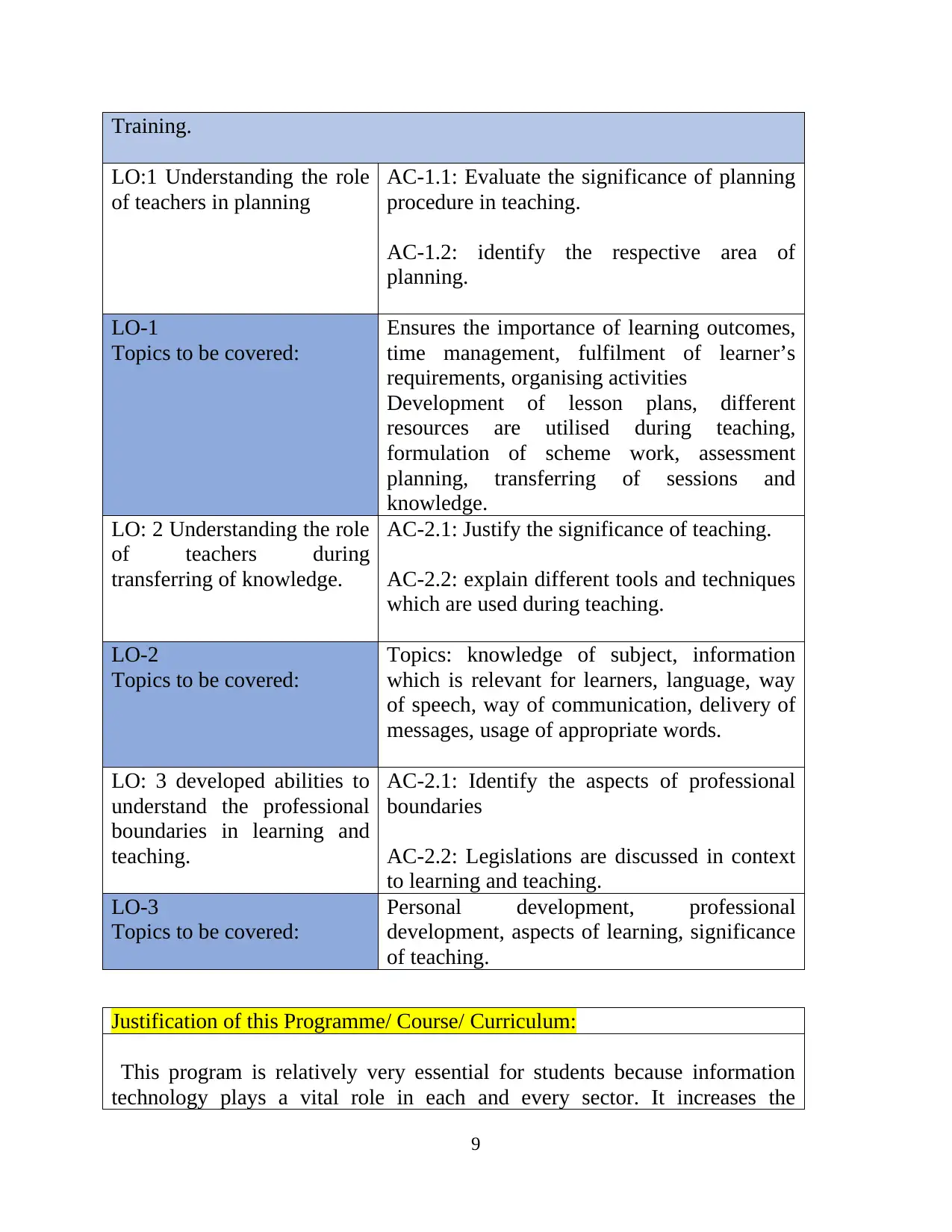
Training.
LO:1 Understanding the role
of teachers in planning
AC-1.1: Evaluate the significance of planning
procedure in teaching.
AC-1.2: identify the respective area of
planning.
LO-1
Topics to be covered:
Ensures the importance of learning outcomes,
time management, fulfilment of learner’s
requirements, organising activities
Development of lesson plans, different
resources are utilised during teaching,
formulation of scheme work, assessment
planning, transferring of sessions and
knowledge.
LO: 2 Understanding the role
of teachers during
transferring of knowledge.
AC-2.1: Justify the significance of teaching.
AC-2.2: explain different tools and techniques
which are used during teaching.
LO-2
Topics to be covered:
Topics: knowledge of subject, information
which is relevant for learners, language, way
of speech, way of communication, delivery of
messages, usage of appropriate words.
LO: 3 developed abilities to
understand the professional
boundaries in learning and
teaching.
AC-2.1: Identify the aspects of professional
boundaries
AC-2.2: Legislations are discussed in context
to learning and teaching.
LO-3
Topics to be covered:
Personal development, professional
development, aspects of learning, significance
of teaching.
Justification of this Programme/ Course/ Curriculum:
This program is relatively very essential for students because information
technology plays a vital role in each and every sector. It increases the
9
LO:1 Understanding the role
of teachers in planning
AC-1.1: Evaluate the significance of planning
procedure in teaching.
AC-1.2: identify the respective area of
planning.
LO-1
Topics to be covered:
Ensures the importance of learning outcomes,
time management, fulfilment of learner’s
requirements, organising activities
Development of lesson plans, different
resources are utilised during teaching,
formulation of scheme work, assessment
planning, transferring of sessions and
knowledge.
LO: 2 Understanding the role
of teachers during
transferring of knowledge.
AC-2.1: Justify the significance of teaching.
AC-2.2: explain different tools and techniques
which are used during teaching.
LO-2
Topics to be covered:
Topics: knowledge of subject, information
which is relevant for learners, language, way
of speech, way of communication, delivery of
messages, usage of appropriate words.
LO: 3 developed abilities to
understand the professional
boundaries in learning and
teaching.
AC-2.1: Identify the aspects of professional
boundaries
AC-2.2: Legislations are discussed in context
to learning and teaching.
LO-3
Topics to be covered:
Personal development, professional
development, aspects of learning, significance
of teaching.
Justification of this Programme/ Course/ Curriculum:
This program is relatively very essential for students because information
technology plays a vital role in each and every sector. It increases the
9
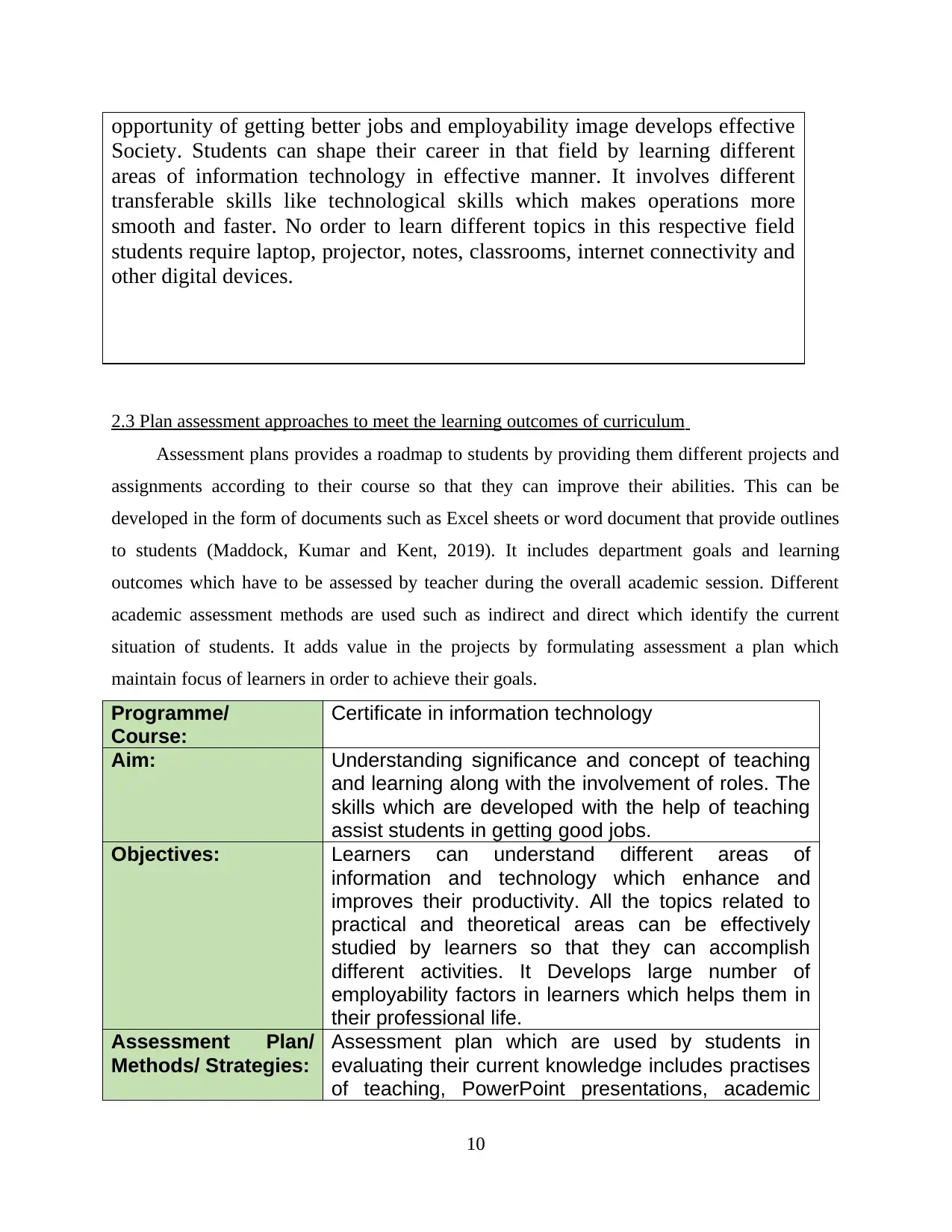
opportunity of getting better jobs and employability image develops effective
Society. Students can shape their career in that field by learning different
areas of information technology in effective manner. It involves different
transferable skills like technological skills which makes operations more
smooth and faster. No order to learn different topics in this respective field
students require laptop, projector, notes, classrooms, internet connectivity and
other digital devices.
2.3 Plan assessment approaches to meet the learning outcomes of curriculum
Assessment plans provides a roadmap to students by providing them different projects and
assignments according to their course so that they can improve their abilities. This can be
developed in the form of documents such as Excel sheets or word document that provide outlines
to students (Maddock, Kumar and Kent, 2019). It includes department goals and learning
outcomes which have to be assessed by teacher during the overall academic session. Different
academic assessment methods are used such as indirect and direct which identify the current
situation of students. It adds value in the projects by formulating assessment a plan which
maintain focus of learners in order to achieve their goals.
Programme/
Course:
Certificate in information technology
Aim: Understanding significance and concept of teaching
and learning along with the involvement of roles. The
skills which are developed with the help of teaching
assist students in getting good jobs.
Objectives: Learners can understand different areas of
information and technology which enhance and
improves their productivity. All the topics related to
practical and theoretical areas can be effectively
studied by learners so that they can accomplish
different activities. It Develops large number of
employability factors in learners which helps them in
their professional life.
Assessment Plan/
Methods/ Strategies:
Assessment plan which are used by students in
evaluating their current knowledge includes practises
of teaching, PowerPoint presentations, academic
10
Society. Students can shape their career in that field by learning different
areas of information technology in effective manner. It involves different
transferable skills like technological skills which makes operations more
smooth and faster. No order to learn different topics in this respective field
students require laptop, projector, notes, classrooms, internet connectivity and
other digital devices.
2.3 Plan assessment approaches to meet the learning outcomes of curriculum
Assessment plans provides a roadmap to students by providing them different projects and
assignments according to their course so that they can improve their abilities. This can be
developed in the form of documents such as Excel sheets or word document that provide outlines
to students (Maddock, Kumar and Kent, 2019). It includes department goals and learning
outcomes which have to be assessed by teacher during the overall academic session. Different
academic assessment methods are used such as indirect and direct which identify the current
situation of students. It adds value in the projects by formulating assessment a plan which
maintain focus of learners in order to achieve their goals.
Programme/
Course:
Certificate in information technology
Aim: Understanding significance and concept of teaching
and learning along with the involvement of roles. The
skills which are developed with the help of teaching
assist students in getting good jobs.
Objectives: Learners can understand different areas of
information and technology which enhance and
improves their productivity. All the topics related to
practical and theoretical areas can be effectively
studied by learners so that they can accomplish
different activities. It Develops large number of
employability factors in learners which helps them in
their professional life.
Assessment Plan/
Methods/ Strategies:
Assessment plan which are used by students in
evaluating their current knowledge includes practises
of teaching, PowerPoint presentations, academic
10
⊘ This is a preview!⊘
Do you want full access?
Subscribe today to unlock all pages.

Trusted by 1+ million students worldwide
1 out of 23
Related Documents
Your All-in-One AI-Powered Toolkit for Academic Success.
+13062052269
info@desklib.com
Available 24*7 on WhatsApp / Email
![[object Object]](/_next/static/media/star-bottom.7253800d.svg)
Unlock your academic potential
Copyright © 2020–2025 A2Z Services. All Rights Reserved. Developed and managed by ZUCOL.


